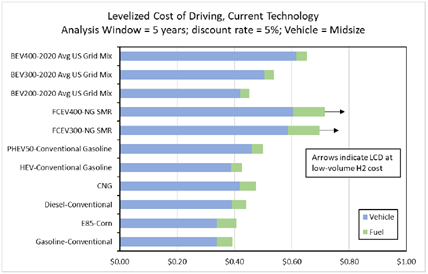Do electric vehicles (EVs) affordably reduce CO2 emissions and save money for their owners despite their higher purchase price? These are questions the researchers at Argonne National Labs sought to answer in an updated report comparing the cost and life-cycle energy use of gas-powered vehicles, electric vehicles, hybrid vehicle, and vehicles using other fuel types.
The findings show that, on average, current EVs are more expensive to operate than comparable gas-powered vehicles over their lifetime, the reduction in CO2 emissions is relatively small, and those reductions likely cost more than the value of the environmental benefits.
Last November, Argonne National Labs released its updated assessment of a “cradle-to-grave lifecycle analysis” that compares the cost of owning and driving a range of vehicles, from gas-powered to 400-mile range electric vehicles.
It is often claimed that electric vehicles are less expensive to operate than gas-powered vehicles because the cost of electricity is so low. Argonne’s analysis, however, shows that even if an EV is owned for 15 years, the levelized cost of driving per mile (which includes purchase and operation) of even the lowest-cost EV is still more than a conventional gas-powered vehicle or a hybrid vehicle like a Prius. This is true for both midsize vehicles and SUVs.
 Using an average ownership period of five years, the cost difference is clearer. The cost of purchasing a low-range EV (200 miles), like a Nissan Leaf or Chevy Bolt, is more than the cost of purchasing and operating a gas-powered vehicle for owners who have the vehicles for five years.
Using an average ownership period of five years, the cost difference is clearer. The cost of purchasing a low-range EV (200 miles), like a Nissan Leaf or Chevy Bolt, is more than the cost of purchasing and operating a gas-powered vehicle for owners who have the vehicles for five years.
The analysis assumes each vehicle is driven an average of 14,231 miles in the first year and 178,102 miles over its lifetime.
The analysis does not include maintenance costs. Although the authors of the Argonne study indicate some studies show maintenance costs for an EV are lower, recent reports from Hertz indicate their rental EV fleet had higher maintenance costs than their gas-powered vehicles.
There are some adjustments that need to be made for Washington state, where gasoline costs are higher and electricity rates are lower than those used in the study. These make EVs in Washington state more attractive than the overall study finds.\
For example, the average fuel cost used by study authors is from the U.S. Energy Information Administration’s 2021 Annual Energy Outlook, which used gas prices from 2020. They estimated the average cost of a gallon of gas at $1.69. This is extremely low compared to the current average in Washington of $4.09 per gallon. However, even if the fuel cost is doubled in the analysis, the lifecycle cost of driving of a low-range EV – about 200 miles in range – is similar to a conventional gasoline car. The Argonne researchers noted, “Vehicle cost is the major (60–90%) and fuel cost the minor (10–40%) component” of costs over the life of the vehicle.
Additionally, Washington’s residential electricity rates are among the lowest, if not the lowest, in the country, about 30% lower than the national average. Reducing the lifecycle cost of electricity for a low-range EV makes the total lifecycle cost similar a conventional gasoline vehicle.
Low-range EVs, like a Nissan Leaf, performed best in the comparisons. For drivers who want a vehicle that can travel farther, an EV with a 300-mile range is significantly more expensive to operate per mile than gas-powered alternatives, even in Washington state.
Comparing a low-range EV to a standard gas-powered car is a bit misleading because the gas-powered vehicles have longer range. In addition to the cost comparison, it is important to remember that gas-powered vehicles are more flexible than low-range EVs.
Some argue that even if an EV is more expensive to buy and operate, the environmental benefits of CO2-reduction make it worthwhile for state governments to subsidize them. The Argonne researchers found that, on average, this is not true.
Comparing current technology gas-powered vehicles to EVs found that over 15 years, long-range EVs avoided 30.6 metric tons (MT) of CO2 emissions and short-range EVs avoided 38.4 MT of CO2. Using California’s most recent price per MT of CO2, the value of the avoided CO2 emissions over the life of an EV is between $1,185 and $1,487 – less than $100 per year. This is significantly less than the combination of federal and state incentives, meaning the government is paying far more for CO2 reduction by subsidizing EV owners than it could if it spent the money on CO2 reductions elsewhere.
Argonne researchers found that the current cost of CO2 reduction using their assumptions ranges from $150/MT of CO2 for a low-range EV, up to an incredible $970/MT for a high-range EV. Mid-range EVs, like a Tesla sedan, had a very high abatement cost of $450/MT CO2. All of those prices are far above market rates and are even above the mid-range of the Biden Administration’s Social Cost of Carbon (SCC) – about $56/MT CO2. The SCC is supposed to estimate the harm done by each metric ton of CO2, so spending hundreds of dollars to avoid one metric ton is actually doing more harm than good.
The report notes that EV technology will likely improve, making them more cost-effective in the future. However, it also calculates that gas-powered, hybrid, and alternative fuel vehicles will also improve, narrowing the potential benefits of future EVs compared to those alternatives.
Washington state has several policies that promote or require the purchase of EVs and subsidize installation of charging stations. If Washington’s goal is to get the greatest reduction in CO2 emissions for the taxpayers’ dollars, EV subsidies may change the econmics of EV ownership for individual owners, but they are an expensive and wasteful way to reduce CO2.





